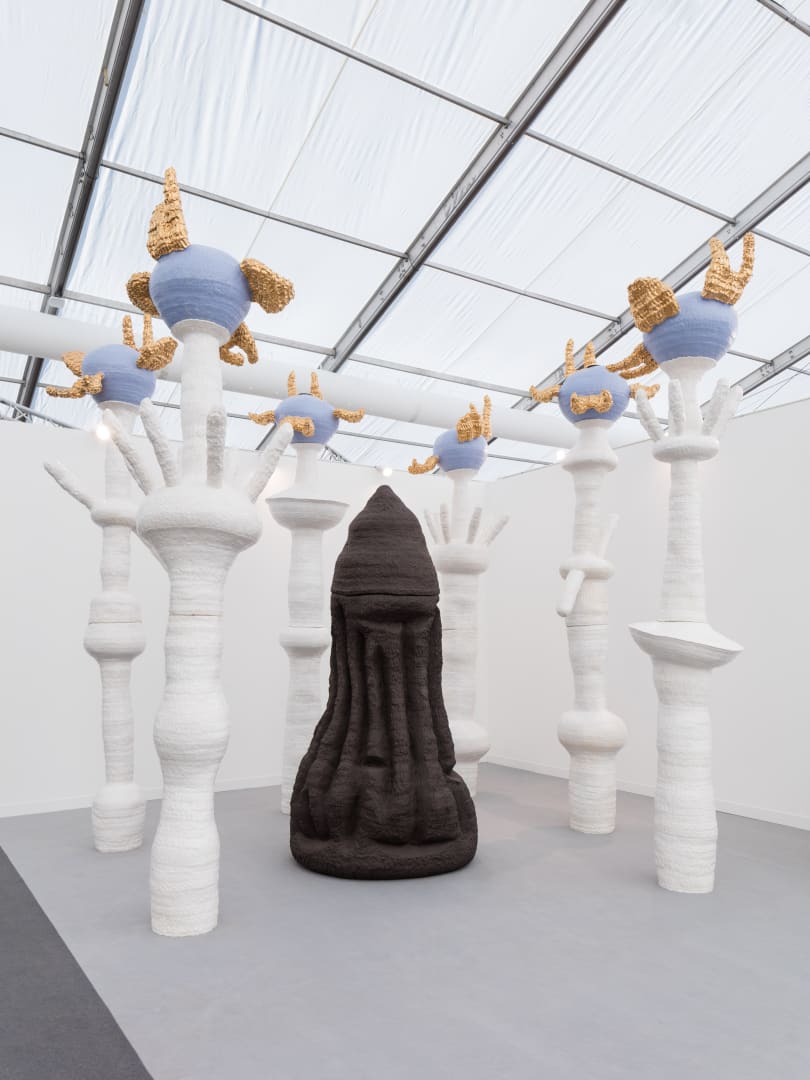Yahweh and the Seraphim was originally conceived as the reredos of a large-scale project initiated in the early ‘90s called the Oratory of Heavenly Space, which Pope intended as a kind of non-denominational chapel, a place of contemplation but without doctrine.The project marked a turning point in Pope’s artistic development both in method and intellectual approach. Pope had received early critical acclaim and, as one of Britain’s leading contemporary sculptors, was chosen to represent Britain at the Venice Biennale in 1980. But during a research trip to Africa in 1982 he contracted a rare form of encephalitis, which left him severely debilitated for nearly ten years. This long period of rehabilitation inevitably led to a shift in approach not least philosophically, but also in the materials and techniques he began to use.
“The idea for the chapel came from the pits somewhere, when I began to think about making work again, but couldn’t get hold of anything,” he writes in the booklet to accompany his 1998 exhibition ‘I Believe or do I’.
“I tried to go back – back and further back – casting about for some primitive substance, I suppose – hitting scriptural bedrock at last...’, he says of the decision to create a chapel, ‘a place of safety and absolution’.
In a move towards softer, more malleable materials such as glass, porcelain, moulded aluminium and ceramics, Pope began to make abstract works referencing complex themes of belief, suicide and society. The installation continues Pope’s career-long fasci- nation with systems of belief, a preoccupation which has become particularly apt in the current political climate, where ‘expertise’ is increasingly mistrusted and beliefs are frequently considered more powerful than rationale. Pope’s interest in the subject dates back to the early 1990s and can be seen in his work Ten Commandment Pots (1992), a set of irregular, seemingly rudimentary, terracotta pots with the ten Christian commandments inscribed on them. This work marked a turning point for Pope as he began connect- ing an examination of constructed moralities with the standards we apply to artworks when judging them ‘good’ or ‘bad’, ‘right’ or ‘wrong’.
The Oratory of Heavenly Space is a non-denominational chapel, not yet in existence, of which Yaweh and the Seraphim being the Reredos makes up an important constituent part, as does The Apostles Speaking in Tongues Lit by Their Own Lamps (1993–96), which was exhibited at Tate Britain in 1996 and Salisbury Cathedral in 2014. The works are all rooted in Christian theology, reflect- ing the artist’s Anglican upbringing, but their abstract and irreverent nature allows Pope to transcend these beginnings, matching them to universal concerns. Overt religious iconography with bright chromaticism and fungal forms provided the sculptures with a singularity and renewed sense of urgency, with the architecture of beliefs becoming a venue for sculptural intervention, in the form of Yahweh and The Seraphim.
Nicholas Pope’s work is held in public collections around the world, including the Guggenheim and the Rijksmuseum Kroller Muller, and he represented Britain at the 1980 Venice Biennale. Well known in the 1970s and 1980s for his large-scale sculptures in wood, metal, stone and chalk, Pope is a contemporary of David Nash, Bill Woodrow and Richard Deacon, along with other sculp- tors who rose to prominence in that period, working against the formalism of the Caro school of sculpture, which was dominant at the time. After the hiatus in his career, the exhibition ‘Nicholas Pope: The Apostles Speaking in Tongues’ (Tate Britain, 1996) marked his return to the public eye. Richard Deacon has said of Pope’s unusual career trajectory:
“It is true that reputation can rest on exposure and that Nick has been underexposed but, to me, he has never gone away, a wonder- ful talent that is always around when I am thinking about making sculpture.”
